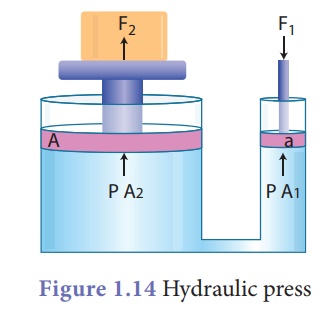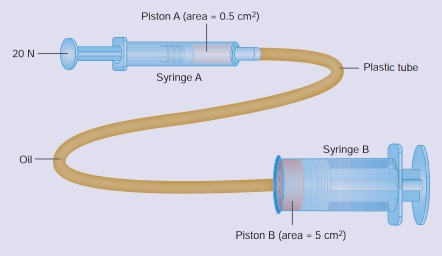Hydraulic press | Fluids - Pascal's Law | 9th Science : Fluids
Chapter: 9th Science : Fluids
Pascal's Law
Pascal's Law
Pascal's principle is
named after Blaise Pascal (1623-1662), a French mathematician and physicist.
The law states that the external pressure applied on an incompressible liquid
is transmitted uniformly throughout the liquid. Pascal’s law can be
demonstrated with the help of the glass vessel having holes all over its
surface. Fill it with water. Push the piston. The water rushes out of the holes
in the vessel with the same pressure. The force applied on the piston exerts
pressure on water. This pressure is transmitted equally throughout the liquid
in all directions (Fig. 1.13). This principle is applied in various machines
used in our daily life.


Hydraulic press
Pascal's law became the
basis for one of the important machines ever developed, the hydraulic press. It
consists of two cylinders of different cross-sectional areas as shown in Figure
1.14. They are fitted with pistons of cross-sectional areas “a” and “A”. The
object to be compressed is placed over the piston of large

The force F1 is applied on the piston of small cross-sectional area
a. The pressure P produced by small piston is transmitted equally to large
piston and a force F2 acts on A which is much larger than F1.
Pressure on piston of small area ‘a’ is given by,
P = F1/A1
………(1)
Applying Pascal’s law,
the pressure on large piston of area A will be the same as that on small
piston. Therefore, P = F2/A2 ……………..(2)
Comparing equations (1)
and (2),we get F1/A1 =
F2/A2 or F2 = F1 x A2/A1
Since, the ratio A2/A1
is greater than 1, theforce F2 that acts on the larger piston is greater than
the force F1 acting on the smaller piston. Hydraulic systems working in this
way are known as force multipliers.
Example 1.5
A hydraulic system is
used to lift a 2000 kg vehicle in an auto garage. If the vehicle sits on a
piston of area 0.5 m2, and a force is applied to a piston of area
0.03 m2, what is the minimum force that must be applied to lift the
vehicle?
Given:
Area covered by the
vehicle on the piston A1 = 0.5 m2
Weight of the vehicle,
F1 = 2000 kg × 9.8 m s–2
Area on which force F2
is applied, A2 = 0.03 m2
Solution:
P1 = P2 ; F1/A1
= F2/A2 and F2 = [ F1/A1]
.A2 ;
F2 = (2000
× 9.8) [0.03/0.5] = 1176 N
Example 1.6
Two syringes are connected
together as shown in the diagram below.
A force of 20 N is
applied to the piston in syringe A.
(a) Calculate the
pressure that the piston in syringe A exerts on the oil.
(b) Calculate the
force needed to just prevent the piston in syringe B from moving out.

Solution:
(a) A force of 20 N is
applied to the piston in syringe A.
The pressure that the
piston in syringe A exerts on the oil,
P = F/A = 20N/0.5cm2
= 40 N cm-2
(b) P = F/A . So F = PA
The force needed to
just prevent the piston in syringe B from moving out,
F = 40 N cm–2
× 5 cm2 = 200 N
Related Topics